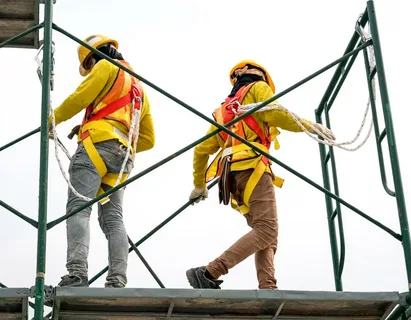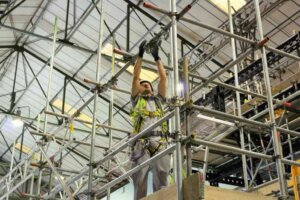Introduction
In New York City dense high rise environment, scaffolding is not merely a tool, it is a regulated safety system and a logistical foundation for all exterior construction, facade work and building maintenance. Selecting the right scaffolding provider is therefore critical for compliance, efficiency and site safety.
Macro Context: Urban Construction Access Systems
This article treats Scaffolding Companies in NYC as the single macro context. Everything that follows, from services and regulations to selection criteria, addresses that one domain rather than merging unrelated contexts.
Core Entities and Attributes
Service Types
- Supported scaffolding systems: ground based pipe or frame or modular systems for facade access and masonry work
- Suspended scaffolding platforms: for high rise work where ground support is impractical
- Sidewalk sheds and pedestrian protection structures: mandated temporary canopies over sidewalks during exterior work
- Engineering and design services: PE stamped drawings, load calculations and custom installations for irregular architecture
- Permit filing and compliance support: companies managing filings with the New York City Department of Buildings DOB, street closures and safety inspections
- Installation, monitoring and dismantling: full service provision including inspections, crew training and removal at project end
Key Attributes
- Licensing and insurance coverage: NYC scaffold contractor licence, workers comp, liability
- Safety protocols and training: OSHA compliance, site specific safety plans
- Urban logistics competency: tight streets, high foot traffic, Manhattan, Bronx, Brooklyn constraints
- Experience with high rise, historic or landmark buildings: complex load, heritage restoration
- Regulatory familiarity: Local Law 11 facade inspection mandates, sidewalk shed requirements
Regulatory and Safety Landscape in NYC
In NYC, scaffolding is governed by stringent rules. All external work above sidewalk level often requires sidewalk sheds. Buildings over six stories must comply with facade inspection programs. Suspended scaffolds require specific engineering and inspection regimes. A reputable scaffolding contractor will manage permits, coordinate with the DOB and ensure weekly inspections and documented training logs.
Choosing an Effective Scaffolding Partner
-
Verify licensing and insurance Confirm the contractor has a valid DOB scaffold licence and covers both public liability and workers compensation
-
Review project experience Look for firms with track records in similar building types such as residential towers, landmark facades or campus renovations
-
Assess engineering capabilities For complex geometry or high rise work, the provider should supply structural drawings and load analyses
-
Evaluate logistical proficiency Urban sites require coordination with street closures, DOT occupancy permits and pedestrian management
-
Prioritise vendors that manage permits Full service companies handle filing, renewals and inspection coordination, reducing your administrative burden
Why the Right Choice Matters
Selecting a competent scaffolding provider impacts your projects timeline, safety record and regulatory exposure. Delays in permit approval, incorrect load design or improper pedestrian shed installation can lead to stop work orders, fines or increased liability. With NYCs dense environment and high pedestrian traffic, the right partner ensures you remain compliant and efficient.
What services do scaffolding companies in NYC provide?
They offer sidewalk sheds, supported scaffolds, suspended platforms, hoists and full compliance services for construction and maintenance.
Are sidewalk sheds required for all NYC projects?
Yes, when exterior work occurs above the first floor, sidewalk sheds are mandated by the Department of Buildings for pedestrian safety.
What is the difference between supported and suspended scaffolding?
Supported scaffolds are ground based and ideal for facade work, while suspended scaffolds hang from the roof for high rise access.
Do scaffold companies manage NYC building permits?
Reputable firms handle DOB filings, renewals and inspections, ensuring projects meet all local regulations.
How do I verify if a scaffold company is licensed in NYC?
You can check the New York City Department of Buildings online license database or request documentation from the provider.
What safety standards must scaffold providers follow in NYC?
They must comply with OSHA regulations, DOB codes and Local Law 11 for facade maintenance.
Can scaffolding be customized for historic buildings?
Yes, experienced providers offer engineered designs to meet load, aesthetic and preservation requirements.
Are emergency scaffold services available in NYC?
Some companies provide rapid response and temporary access structures for urgent repairs or DOB violations.
What qualifications should scaffold installation crews have?
Crews should be OSHA trained, experienced in urban logistics and familiar with NYC construction protocols.
How early should I book a scaffold company in NYC?
Ideally, at least four weeks in advance to accommodate design, permitting and logistical planning.
Conclusion
Scaffolding companies in New York City are fundamental enablers of exterior construction, renovation and maintenance. A provider that offers engineered design, full regulatory support, safety first crews and urban logistics experience will serve as a strategic partner, not merely a supplier. Focus your selection on the entities and attributes outlined above to align with NYCs demanding environment and ensure project success.



